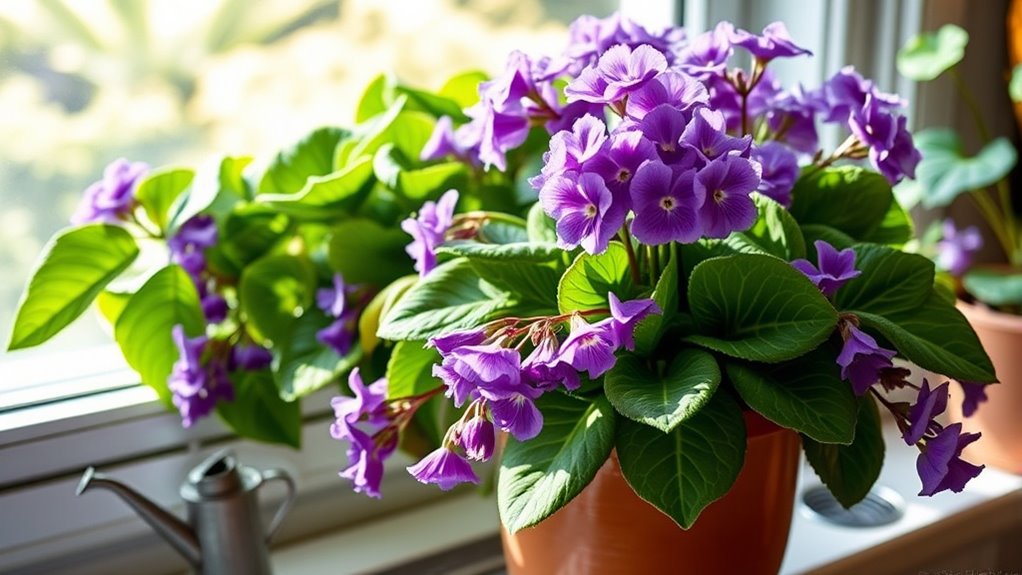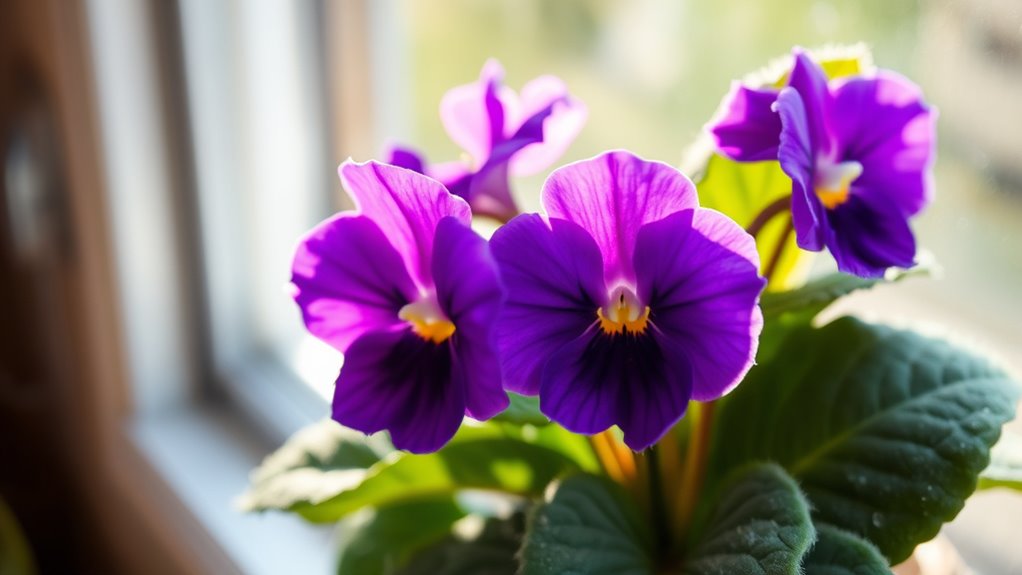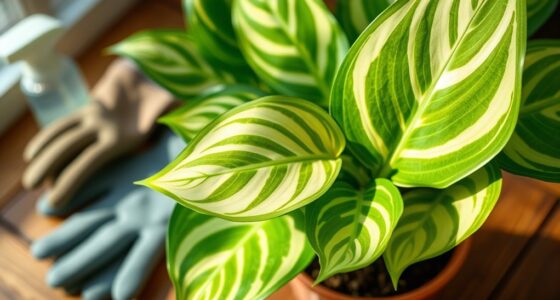To keep your African violets blooming on the windowsill, water only when the top inch of soil feels dry, using room-temperature water and avoiding splashes on the leaves. Regular pest checks and gentle removal of any pests help keep your plant healthy. Ensure good airflow and avoid overcrowding for ideal growth. Following these tips consistently will help your violets stay vibrant and continue blooming beautifully, with more expert advice available if you want to improve your care skills.
Key Takeaways
- Water only when the top inch of soil feels dry, using room-temperature water to prevent overwatering and root rot.
- Ensure bright, indirect light near the windowsill to promote continuous blooming.
- Maintain good airflow and avoid overcrowding to reduce humidity and pest issues.
- Regularly inspect for pests like aphids or spider mites and remove them promptly.
- Keep soil evenly moist and avoid splashing water onto leaves to support healthy, vibrant blooms.

Are you wondering how to keep your African violet thriving? The key is establishing a consistent watering schedule and practicing effective pest prevention. These plants are delicate, so understanding their watering needs is vital. You want to keep the soil evenly moist but never soggy. To do this, water only when the top inch of soil feels dry. Use room-temperature water, ideally from a watering can with a narrow spout, to avoid splashing water onto the leaves, which can cause spots or rot. Avoid overwatering, as excess moisture can lead to root rot, while underwatering can cause the leaves to wilt and fade. Setting a regular watering routine helps your violet stay healthy and encourages continuous blooming. Incorporating proper watering practices aligned with the plant’s needs further supports its overall health.
Pest prevention is equally important in maintaining a vibrant African violet. Keep a close eye on your plant for common pests like aphids, mealybugs, and spider mites. These tiny invaders can quickly damage your violet’s delicate leaves and flowers, so early detection is vital. To prevent pests, ensure your plant isn’t overcrowded, which can trap humidity and foster infestations. Regularly inspect both the upper and undersides of leaves, and remove any visible pests by gently wiping them away with a soft cloth or using a mild insecticidal soap if needed. Also, quarantine new plants before introducing them to your indoor garden to prevent bringing in pests from outside sources.
Your watering schedule and pest prevention efforts work hand in hand. For example, overwatering can create a humid environment that invites pests, so sticking to a proper watering routine helps keep pests at bay. Additionally, maintaining good airflow around your plant reduces humidity levels that pests love. Using clean tools and pots also prevents the spread of diseases and pests. If you notice any signs of pests or disease, act swiftly—remove affected leaves, adjust watering practices, and treat your violet with suitable organic pest control methods. Consistency is vital in both watering and pest management; a healthy, well-cared-for plant is less susceptible to problems and will reward you with abundant, beautiful blooms.
Frequently Asked Questions
How Often Should I Repot My African Violet?
You should repot your African violet every 6 to 12 months to maintain healthy soil drainage and prevent root rot. When repotting, choose a slightly larger container with good drainage holes. This helps regulate watering frequency, as fresh soil retains moisture better and prevents overwatering. Keep an eye on your plant’s growth and signs of cramped roots, repotting promptly to keep it thriving and blooming beautifully.
Can African Violets Thrive Outdoors?
African violets generally prefer indoor environments, but if you want outdoor growth, you need to take climate considerations carefully. They can thrive outdoors in mild, shaded areas with consistent moisture, but avoid direct sunlight and extreme temperatures. You must also protect them from wind and pests. Keep in mind, their delicate leaves and blooms may not be as vibrant outside, so monitor conditions closely to ensure healthy growth.
What Is the Best Fertilizer for African Violets?
Think of your African violet as a delicate artist, thriving on the right tools. The best fertilizer types are balanced, like a gentle palette, with equal parts nitrogen, phosphorus, and potassium. Use a water-soluble fertilizer every 4-6 weeks during active growth, ensuring consistent nourishment. Avoid overfeeding, as too much can harm your plant. Proper application frequency keeps your violet vibrant, making it a true masterpiece on your windowsill.
How Do I Prevent Pests on My Violets?
To prevent pests on your violets, start with pest identification by regularly inspecting leaves and stems for signs of insects. Use organic pest control methods like neem oil or insecticidal soap to keep pests at bay without harming your plant. Keep the environment clean and avoid overwatering, which can attract pests. Consistent monitoring and prompt treatment help make certain your violets stay healthy and pest-free.
Why Are My African Violet’s Leaves Turning Yellow?
Did you know that over 80% of African violet owners report yellowing leaves at some point? If your violet’s leaves are turning yellow, it’s likely due to overwatering, which affects leaf texture and disrupts nutrient flow. Check your watering habits, guarantee proper drainage, and avoid wetting the crown. Adjusting these factors helps restore healthy leaf color and keeps your plant vibrant, encouraging more beautiful blooms.
Conclusion
With a little gentle attention, your African violet will serenade you with its delicate blooms, brightening your days like a quiet whisper of nature’s grace. As you nurture it on your windowsill, you create a cozy haven where beauty quietly flourishes. Embrace the small joys of caring for your violet, and let its subtle charm remind you that patience and kindness often bring the most lovely surprises. Your windowsill can become a sanctuary of gentle wonder.









